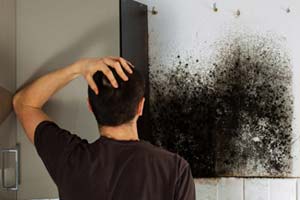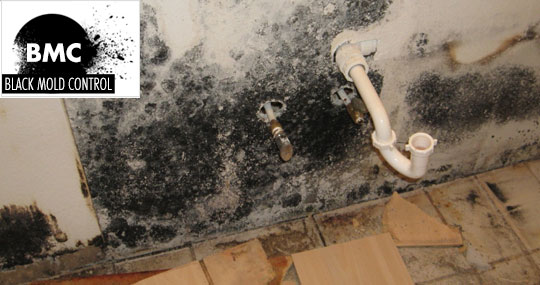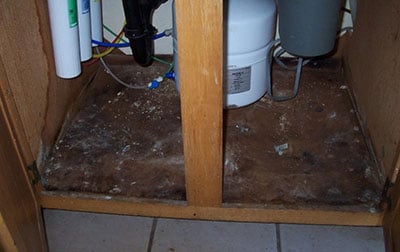How to Remove Mold From Kitchen Cabinets
Are you concerned that black mold could be lurking in your kitchen, perhaps hiding in the cupboards? Not only is it unattractive, it can also cause respiratory problems for your family. The following guide can help you locate, prevent and destroy any black mold that has taken up residence in your kitchen.

Table of Contents
- What is mold?
- Where to find kitchen mold?
- Under kitchen sink
- Under refrigerator
- Behind cabinets
- Kitchen mold removal
- Natural ways to clean and remove mold
- Best kitchen mold cleaners
- Kitchen mold prevention
- Mold-resistant products
By various accounts in the building industry, the kitchen — once relegated to its traditional function as the place for preparing and eating meals — is now the self-respecting home's epicenter. A review of Kitchen Kulture, Michelle Galindo's 2015 book on the room's importance to daily living, says it's "a stage on which the act of cooking and eating is celebrated as a social event. At the same time, the kitchen is being opened up to become a living space and pivotal meeting point in the home."
The kitchen is indeed the focus of the home today. The irony is that it also may harbor a toxin whose ill-effects can touch It for the worse.
What is black mold?
Black mold, or Stachybotrys atra, is a black and green fungus that can fuel symptoms of illness in susceptible people. Its components release catalysts for mycotoxicosis, or black mold poisoning, which may occur with inhalation of these elements.
Symptoms include coughing, wheezing, runny nose, red eyes and nosebleed; asthmatics and people with weakened immune systems are less resistant to the effects and can experience persistence coughing, allergic reactions, anxiety and lethargy.
Black mold grows around cabinets and water fixtures amid its requirements for moisture; the good news is that that moisture dampens downward, preventing it from contaminating the air. The bad is that it's colossally unsightly, staining cabinets and sink undersides with slime and discoloration.

Where to find black mold in the kitchen?
Black mold tends to grow in dark, damp areas, which means it could be festering in a kitchen cabinet or cupboard for a long time before you uncover it. For this reason, it's vital that you identify the areas in your kitchen that are going to be most prone to mold growth. This will give you the necessary knowledge so that you can find the problem before it gets too bad. Beneath you'll find several places to check for the fungi.
Under kitchen sink
 Check the cabinet bottom and the back wall where the sink pipes enter for dampness or past signs of water damage, such as bubbling or peeling surfaces. Even if black mold isn't visible, it could be growing on the underside of the sink cabinet or behind the wallboard. Read our in-depth article on: how to remove mold under a sink.
Check the cabinet bottom and the back wall where the sink pipes enter for dampness or past signs of water damage, such as bubbling or peeling surfaces. Even if black mold isn't visible, it could be growing on the underside of the sink cabinet or behind the wallboard. Read our in-depth article on: how to remove mold under a sink.
Under the refrigerator
A leak from a water line to the ice maker or simple condensation collection underneath the fridge could create the optimum environment for fungal growth. If your kitchen flooring looks like it has suffered water damage or if there is standing water and mildew present, black mold could also be growing under the floorboards. Also, check any cupboards near the fridge to make sure there is no moisture damage.
Behind kitchen cabinets
Cabinets above or next to wall mounted microwaves or oven hoods. Another common trouble spot is behind the cabinets that border microwaves and hoods. This is because moisture and condensation from cooking can accumulate in these cupboard areas, especially if ventilation is insufficient.
Black mold in the kitchen isn't the end of the world, nor does it reflect upon the longterm safety of your home. With the help of remediation and removal your kitchen can be free of fungal issues and problem moisture.
Kitchen mold removal
Black mold can be tenacious when it comes to removal. Although you can often remove the visible black mold by yourself, there is likely hidden mold that you cannot find for removal as easily. The basic removal process is as follows:
Step 1: Testing Testing is done if there is signs of moisture but no obvious visual signs of fungal growth. Testing may also be done if there is light visible growth, since the remediation firm will need to determine the extent of the growth.
Step 2: Seal the infested area The home is sealed. This means that the area that has mold, in this case the kitchen, is sealed off from the rest of the house so that black mold removal doesn't send spores into other areas.
Step 3: Identification and replacement The cause of moisture is identified and fixed. Otherwise, the mold will simply return if there is still a moisture source. This may mean the removal and replacement of cabinets and wallboard so they cleaning can occur under them.
Last step: Removal and cleaning The actual removal and remediation begins. The crew will use a disinfecting and cleaning solution that removes and kills the fungus. Stains from the black mold may be present on cabinets, but these can usually be painted over and repaired.
4 ways to remove and clean kitchen mold
This list cites nontoxic, no-bleach methods to kill and remove black mold in kitchen areas. All materials are inexpensive and readily available.
- Pour hydrogen peroxide in 3 percent concentration into a spray container, saturating the affected surface and letting it work for ten minutes. Scrub the surface, then wipe it down to remove remnants.
- Spray white distilled vinegar full-strength onto the area and let it sit for 60 minutes. Wipe the area with water and allow it to dry.
- Add a quarter tablespoon to a spray bottle of water and shake the bottle until the soda has dissolved. Spray the affected area and remove the remnants with a scrub brush, rinsing the area for a cleaner surface.
- Mix one teaspoon of tea tree oil per cup of water in a spray bottle and clean the area, taking care not to rinse.
Best kitchen mold cleaners
The RMR mold cleaner family is advertised as a particularly easy-to-use spray and allegedly takes care of the problem quickly, especially around cabinets. Puracy's five-member organic cleaner set was created by a team of physicians. CISNO makes an air filter said to eliminate virtually all mold pollen in rooms up to 80 square feet, while Brison markets a set of drill attachments designed to clean household surfaces.
Kitchen mold prevention
Since prevention is key to black mold management in the home, now that you know your kitchen's trouble spots you are better able to stop it from growing in the first place.
Begin by checking underneath the sink on a regular basis and fixing leaks immediately. Keep the sink cupboard area clean and neat so you can empty it out for a quick leak check regularly. If you are like many people and use this cupboard area for cleaning supplies, place the supplies in a handled carrier so you can quickly pull everything out. A good time to check is after you have been using the sink, such as after dishwashing. If there is a leak, it is likely going to be damp if you just drained the sink.
 As for the fridge, it's good practice to pull it out and dust the rear coils every one to two months, anyway. Simply pencil this chore into your home maintenance calendar. You can then use this opportunity to check beneath the fridge for leaks and to make sure water lines are attached and not leaking.
As for the fridge, it's good practice to pull it out and dust the rear coils every one to two months, anyway. Simply pencil this chore into your home maintenance calendar. You can then use this opportunity to check beneath the fridge for leaks and to make sure water lines are attached and not leaking.
Finally, inspect the area around and under the cabinets, microwave, and hood after you use the oven or microwave. If you find a lot of moisture or condensation, chances are that you need to add a stronger fan or better ventilation to the kitchen.
Mold-resistant products for kitchen
Certain paints, tiles and caulk come in editions resistant to black mold. KILZ bonding primer bonds paint to latex or oil topcoats on kitchen cabinets and surfaces such as vinyl, glass and tile. Resistant marble peel-and-stick tiles, which take minutes to apply as backsplash without tools, or Marrone's gel-based tic tac tiles that cling to sleeker surfaces, make clean replacements around cabinets to areas overrun with mold. Flex Shot caulk will clean, bond and seal around cabinets without the need for a caulking gun and expands and contracts around holes to keep the affected area resistant.
Black mold has its challenges, especially as they may affect your family's health. Fortunately, those challenges are easily met, enhancing the look and function of your home's new epicenter.
How to Remove Mold From Kitchen Cabinets
Source: https://blackmoldcontrol.com/kitchen/
0 Response to "How to Remove Mold From Kitchen Cabinets"
Post a Comment